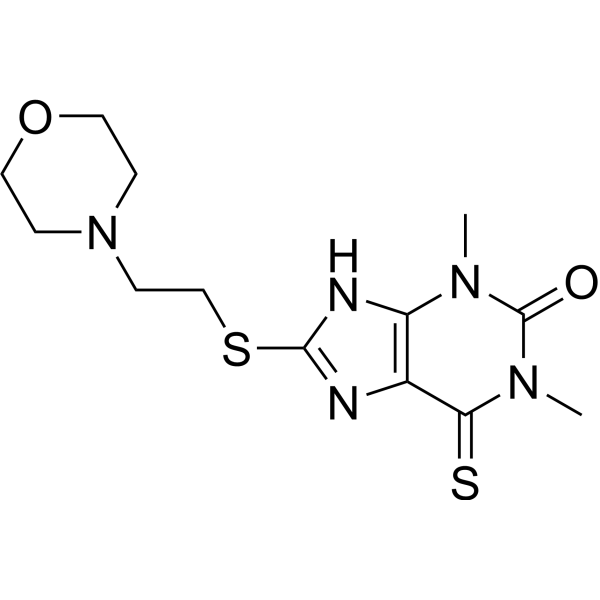Physicochemical Properties
| Molecular Formula | C13H19N5O2S2 |
| Molecular Weight | 341.45 |
| Exact Mass | 341.098 |
| CAS # | 6505-99-3 |
| PubChem CID | 4361023 |
| Appearance | White to off-white solid powder |
| Density | 1.48g/cm3 |
| Boiling Point | 562.5ºC at 760 mmHg |
| Flash Point | 294ºC |
| Index of Refraction | 1.704 |
| LogP | 0.691 |
| Hydrogen Bond Donor Count | 1 |
| Hydrogen Bond Acceptor Count | 6 |
| Rotatable Bond Count | 4 |
| Heavy Atom Count | 22 |
| Complexity | 446 |
| Defined Atom Stereocenter Count | 0 |
| InChi Key | XHNSOGDMSSHQFY-UHFFFAOYSA-N |
| InChi Code | InChI=1S/C13H19N5O2S2/c1-16-10-9(11(21)17(2)13(16)19)14-12(15-10)22-8-5-18-3-6-20-7-4-18/h3-8H2,1-2H3,(H,14,15) |
| Chemical Name | 1,3-dimethyl-8-(2-morpholin-4-ylethylsulfanyl)-6-sulfanylidene-7H-purin-2-one |
| Synonyms | JA2131 |
| HS Tariff Code | 2934.99.9001 |
| Storage |
Powder-20°C 3 years 4°C 2 years In solvent -80°C 6 months -20°C 1 month |
| Shipping Condition | Room temperature (This product is stable at ambient temperature for a few days during ordinary shipping and time spent in Customs) |
Biological Activity
| ln Vitro | In PC3 cells, JA2131 (10 mM; 1-2 h) causes hyperPARylation of PARP1[1]. At 10 μM for two weeks, JA2131 suppresses MCF-7, PC3, and MDA-MB-231 cell colony formation. At 0.1 μM-1 mM for seventy-two hours, it exhibits cytotoxicity, inhibiting MRC-50 cells with an IC50 value of 132 μM[1]. The viability of PC3 and A172 glioblastoma cells is inhibited by JA2131 (5 μM; 72 h)[1]. In HeLa cells, JA2131 (10 μM; 2 h) may be acting at the replication fork[1]. |
| Cell Assay |
Cell Viability Assay[1] Cell Types: PC3, and A172 glioblastoma cells Tested Concentrations: 0.1 μM-10 mM Incubation Duration: 72 hrs (hours) Experimental Results: Inhibited cell viability with IC50s of 33.05 μM (PC3 cells) and 55.34 μM (A172 cells), respectively. |
| References |
[1]. Selective small molecule PARG inhibitor causes replication fork stalling and cancer cell death. Nat Commun. 2019 Dec 11;10(1):5654. [2]. Targeting SARS-CoV-2 Nsp3 macrodomain structure with insights from human poly(ADP-ribose) glycohydrolase (PARG) structures with inhibitors. Prog Biophys Mol Biol. 2021 Aug;163:171-186. |
Solubility Data
| Solubility (In Vitro) | DMSO : ~12.5 mg/mL (~36.6 mM) |
| Solubility (In Vivo) |
Solubility in Formulation 1: ≥ 1.25 mg/mL (3.66 mM) (saturation unknown) in 10% DMSO + 90% Corn Oil (add these co-solvents sequentially from left to right, and one by one), clear solution. For example, if 1 mL of working solution is to be prepared, you can add 100 μL of 12.5 mg/mL clear DMSO stock solution to 900 μL of corn oil and mix evenly. (Please use freshly prepared in vivo formulations for optimal results.) |
| Preparing Stock Solutions | 1 mg | 5 mg | 10 mg | |
| 1 mM | 2.9287 mL | 14.6434 mL | 29.2869 mL | |
| 5 mM | 0.5857 mL | 2.9287 mL | 5.8574 mL | |
| 10 mM | 0.2929 mL | 1.4643 mL | 2.9287 mL |
